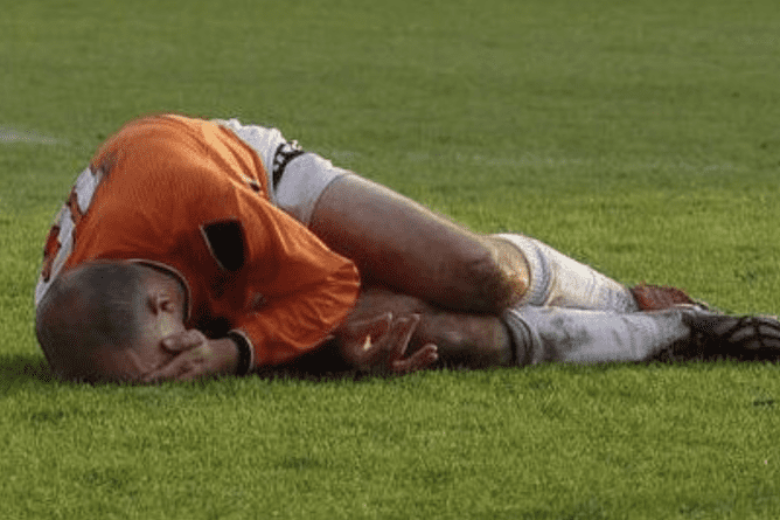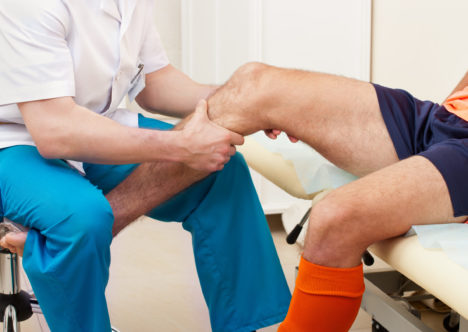Use our convenient online scheduler to book an appointment now.

A patellar dislocation is a violent injury of the knee. It describes when the knee cap (patella) comes out of the joint completely. The patella almost always comes out towards the outer side of the knee. Most frequently a patellar dislocation occurs during an athletic activity. On occasion it can occur during a fall or nonathletic activity in which the knee of a planted foot gets twisted. Less commonly, the patella gets hit on its inside and is pushed towards its outside. See this earlier post for a more in depth discussion of the knee’s anatomy and patellar instability.
Patellar Dislocation: Symptoms
The symptoms of a patellar dislocation are very distinct. The classic symptoms are:
- Acute traumatic injury
- A “pop”
- Significant pain
- Inability to continue activity
- Rapid onset swelling
- Progressive stiffness
These symptoms are very similar to those which occur with an acute ACL tear. There are some additional symptoms that differ from that of an ACL tear. These are:
- +/- Persistent deformity (the patella can be seen on the side of the knee and is therefore absent from the front of the knee)
- +/- A frequent second injury or “pop” (when the knee cap snaps back in place)
- Pain on the inside (medial) side of the knee cap and knee
Patellar Dislocation: Diagnosis
The diagnosis of patellar dislocation is typically made by your sports medicine knee specialist simply by the history that you provide. When the diagnosis is in question, an examination of your knee will usually confirm it. Often an X-ray will be taken to make sure that no breaks in the knee bones have occurred as the knee cap came out of place or, more commonly, when it went back in. Additional information abut the shape and position of the various knee bones can also be determined by X-ray. For those cases in which the diagnosis is still unclear or for surgical planning, an MRI may also be helpful.
Patellar Dislocation: Treatment
If the patella is not in place, straightening the knee and sometimes pushing gently on the knee cap’s outer side, toward your opposite knee will correct this.
Once the patella is back in place or of it doesn’t easily go back in place, you should see a doctor. After they put your kneecap back in place, if needed, they will most likely begin your treatment. This initial treatment consists of measures to reduce your pain, stiffness and weakness as well as help you get around safely. Typically this includes relative rest, ice and pain medicine (as needed). Often a brace or immobilizer is used for several weeks. This allows the injured tissues to “rest” and potentially to heal. It also gives time for the pain to improve and it enables safe, painless walking. Frequently an exercise program either at home or with formal physical therapy will be started as well. Once this initial phase is over, the definitive care can begin.
After an initial patellar dislocation, the risk of recurrence is somewhere between 15-40%. Therefore more people are likely to not have another dislocation than are. For this reason, it is reasonable to try nonsurgical care after your first patellar dislocation. In fact, even after a second dislocation, the risk for a third dislocation is only about 50-50. So you and your doctor may decide to continue nonoperative care even with two dislocations. As one has more dislocations, particularly if they are younger (teens and twenties) and more active, the risk of recurrences goes up and surgery becomes a more necessary option.
Nonsurgical treatment
The main components of nonoperative treatment are:
- Physical Therapy
- +/- Protective bracing
Surgical Treatment
Surgery is an effective way to stop recurrent dislocations. Modern surgical procedures can be performed as an outpatient and have very good success rates. These techniques usually include a repair or more often a replacement (reconstruction) of the main stabilizing ligament of the patella (the Medial Patellofemoral Ligament (MPFL)). On occasion, a correction of inappropriate patellar position or bony deformity will also be needed. If there are loose fragments in the knee or larger breaks in the bone, surgery may be required to treat these as well.
Join our Mailing List
TCO provides patients with orthopedic problems the trusted resources and patient-centered advice they need to “Feel Better. Move Better. Be Better.”
© 2024 Town Center Orthopaedics | All Rights Reserved


